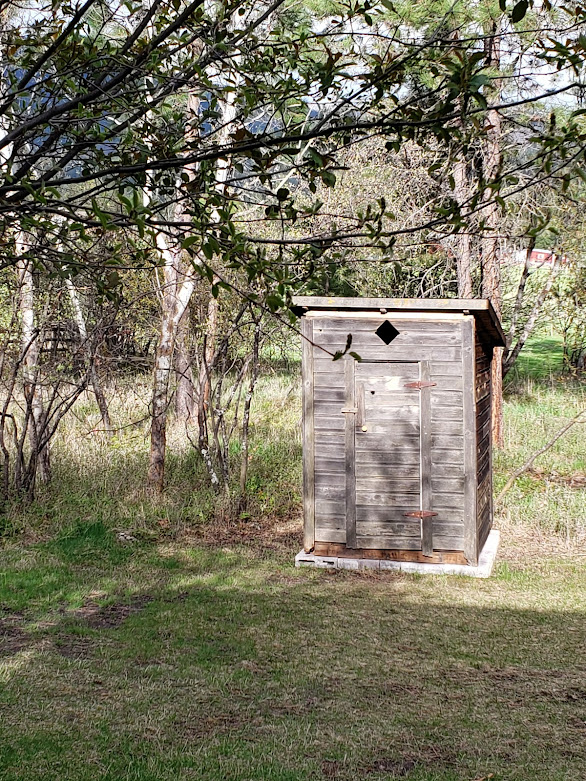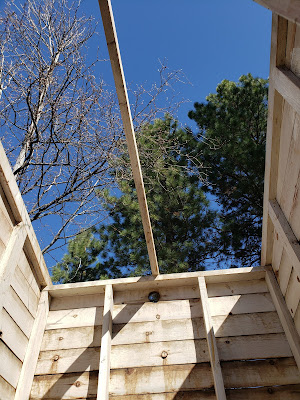How I Spent My COVID Staycation
I was sitting at my computer working from home and it popped up online.
“For sale: old outhouse. Price: $20.” It immediately caught my eye for three
reasons. One, I like old, cool-looking stuff. Two, only 20 bucks?! And three,
this just might work.
You see, I was in the process of accumulating pallets in order to build
a shed for storing my firewood. I found a couple of photos of pallet sheds and
a semi-decent YouTube on how to do it. I gathered six pallets already but the
challenge is they come in all sizes and I needed four more of the same height
and width to start the job. That was proving to be difficult. But as I looked
at this Facebook post I thought, “That’s not your normal outhouse. It looks…wider,
bigger. And it looks pretty stout, too. Forget the pallet shed. This could work
just fine.”
I responded to the post and turns out I was the first to do so. I
struck up a conversation with the owner who later said, “I’m getting inundated
with calls on this, LOL. Come and get it.”
I immediately unloaded a car from my son-in-law’s trailer, hooked it up
to my truck and drove 45 miles south to the Bitterroot Valley, one of my
favorite scenic drives.
 |
| The ever-so-romantic "double-seater" |
 |
| All loaded & ready for return trip |
We secured a large car-towing strap around the outhouse and the man
used his tractor with forks on the front of it to lift it on the trailer and
then eventually pushed it back between the wheel wells, the best place for weight
of any kind to be supported by the trailer. We solidified its position with
four additional straps. The whole process took about 40 minutes or so. When we
were done, I was very grateful. I paid him $20 and then emptied the rest of my
wallet as well – probably another 17 or 18 dollars. He was just so helpful and
went above and beyond to help me out.
I was a little leery on the drive home toting that thing. I was hoping
old boards weren’t flying off as I went. My pickup drew a lot of stares in
traffic and even some pointed fingers from several people. When I finally got
home I did notice one loose board fell off but it was still on the trailer. I’m
guessing a bunch of old wooden shake shingles fell off in transit as well.
Getting it off Kenny’s trailer and placed onto a foundation we made out
of slender cinder blocks would be a challenge. Kenny and I stood and thought
out loud how we could move it what amounted to 10-feet or so without tipping it
over or ruining the cinder blocks. My next door neighbor, Bill, has a small front end
loader, saw the trailered outhouse and volunteered to lift it into place. The
back of the loader came off the ground when he lifted it with his forks but we
managed to get it into place. Thanks Bill!
Once in place, I measured it. Sure enough, it was a decent size – more
than five feet wide by six and a half feet deep by seven feet tall. Yes indeed,
that would work well to hold the wood and in such a scenic setting in the woods
just off the side of our house.
 |
| Bye bye double-seater |
Now it was time for me to get to work. After peeling off the wooden shake shingles, I tore off the roof. Then I demoed the “seating area” and used the best of the old roofing planks to fill out the rest of the floor. I cut a couple of sheets of plywood, nailed them to the roof studs and then shingled the roof. After tearing out some rotten boards below the door and replacing them with leftover rooting planks, it was as structurally sound as I could make it. I gave the exterior one coat of wood finish.
 |
| Stacked & ready for winter |

About a week later, Lori and I rolled up our sleeves and loaded the
outhouse with previously cut and split lodgepole pine.
 |
| Facelift complete |
Now, what was once a part of Montana history is back in “business,” refinished and being utilized for the first time in decades.
 |
| The final resting place back in the woods of Montana |



No comments:
Post a Comment